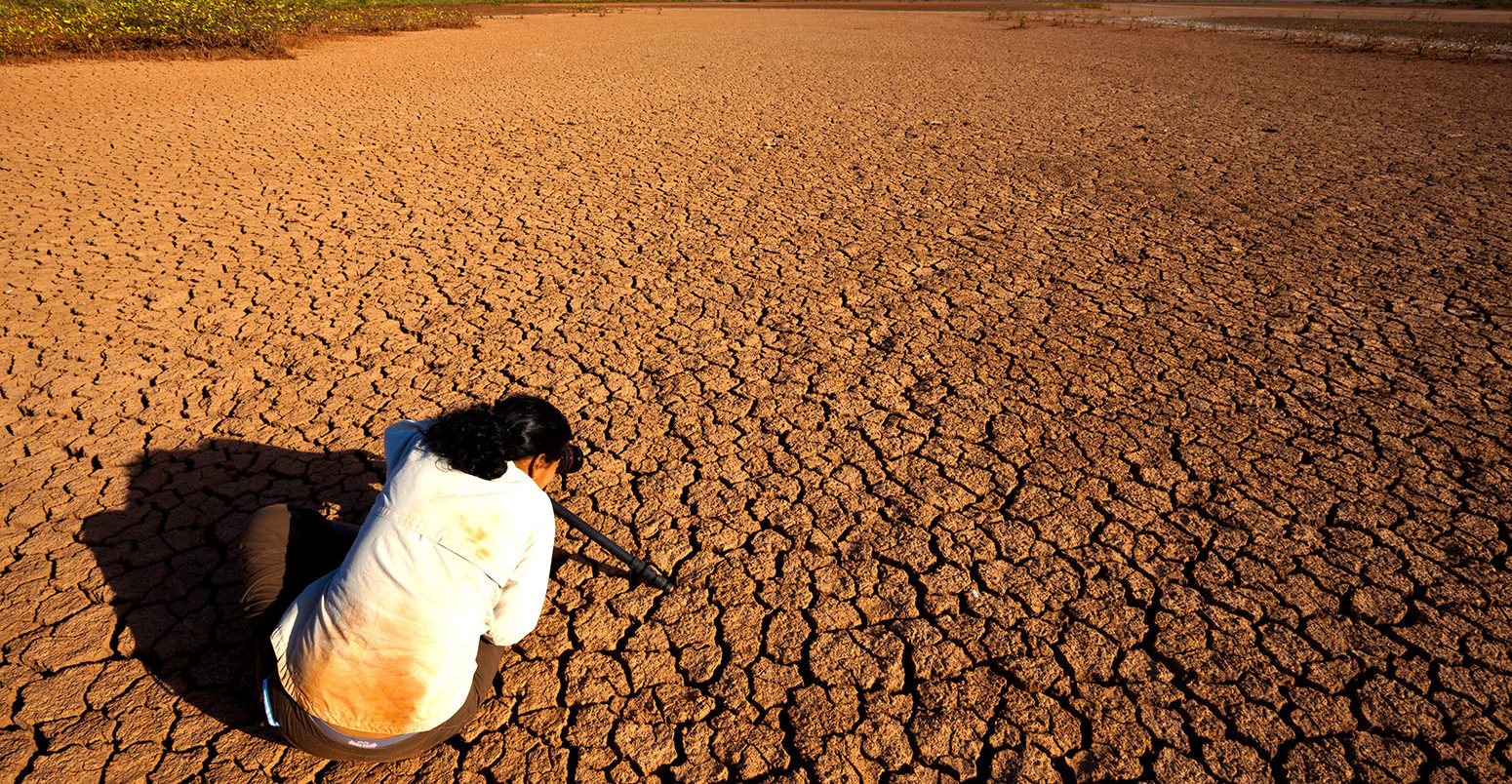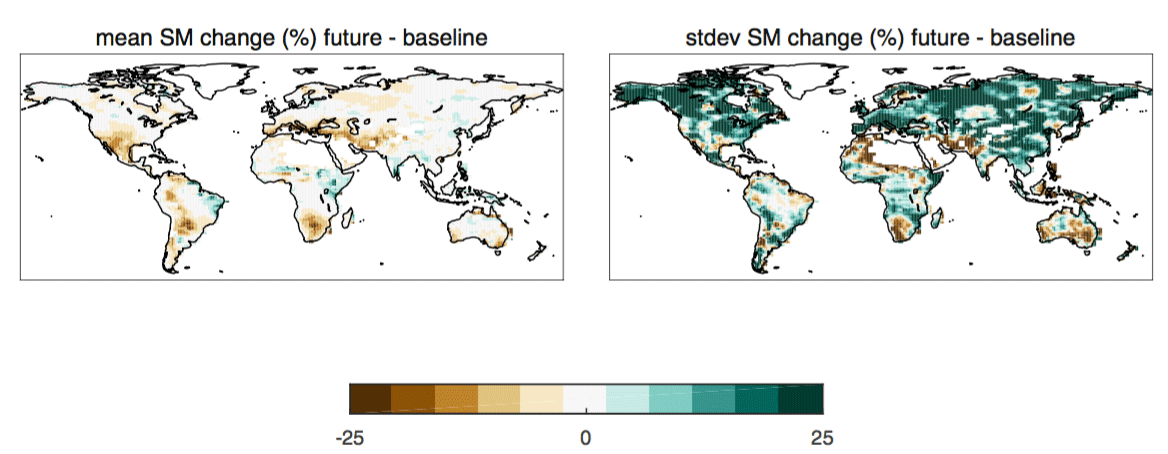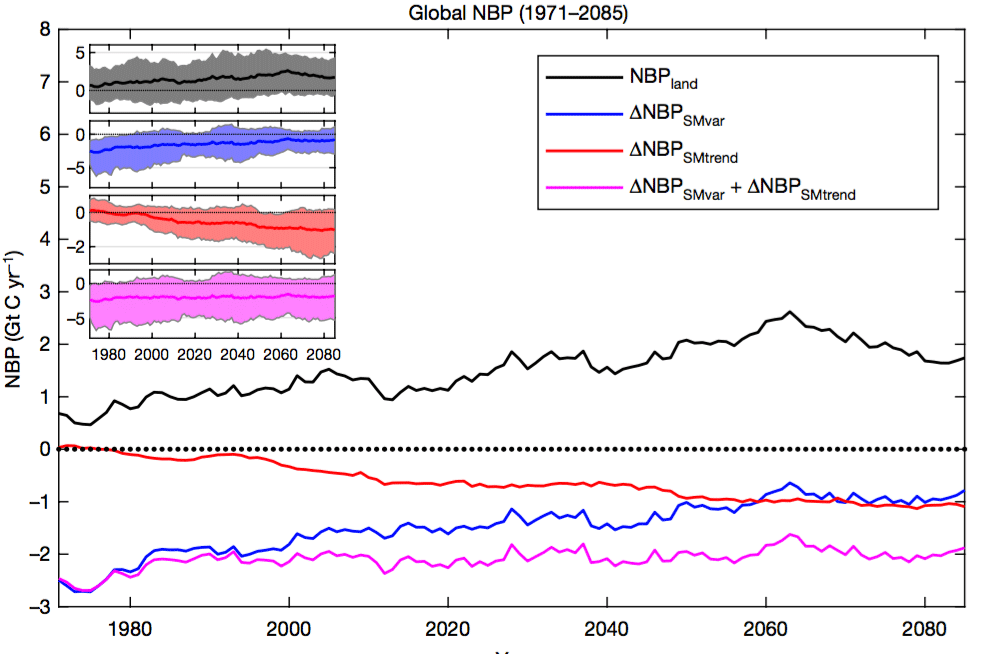
Climate change’s impact on soil moisture could push land past ‘tipping point’
Daisy Dunne
01.23.19Daisy Dunne
23.01.2019 | 6:00pmThe impact of climate change on soil moisture could push the land past a “tipping point” – turning it from a net carbon “sink” to a source of CO2, a study finds.
The research, published in Nature, shows that levels of soil moisture – which are impacted by rising temperatures and extreme events such as droughts – can have a “large negative influence” on the land’s ability to store carbon.
It finds that the rate at which land absorbs carbon is likely to increase until the second half of this century as a result of the “CO2 fertilisation effect” – a phenomenon where increased CO2 levels in the atmosphere bolsters the growth and, therefore, carbon uptake of plants.
However, after this point, the fertilisation is expected to “reach a peak”, the lead author tells Carbon Brief. This peak – combined with the negative impact of soil moisture changes – could turn the land “from a carbon sink to a carbon source, greatly accelerating climate change”, she says.
The findings represent “a big step forward to show that soil moisture changes play a really important role” in how the land stores carbon, another scientist tells Carbon Brief.
Turned to dust
The land stores around 40% of all the CO2 released by humans. Most of this carbon is held in forests, which absorb CO2 during photosynthesis and then use it to build new shoots, leaves and wood. Some carbon is transferred to forest soils when plants die.
Though the land is an important carbon sink, it is not fully understood how its ability to soak up CO2 could change as the world warms, says Julia Green, a PhD student from the Department of Earth and Environmental Engineering at Columbia University and lead author of the study.
Her research finds that levels of soil moisture could have a “large influence” on the land’s ability to store carbon. This is because, when soils are dry, plants stop carrying out photosynthesis, she says:
“Plants lose water when they perform photosynthesis. Therefore, many species stop when water supplies are depleted, meaning they aren’t taking in carbon anymore. The loss of water during photosynthesis is called “transpiration” and it has a cooling effect on the surrounding environment.
“As a result, when it is dry and transpiration stops, it can result in warming temperatures. Warming temperatures increase rates of respiration – the loss of carbon from soil and vegetation.”
Parched earth
![]()
For the study, the researchers used data from four global climate models to explore how soil moisture changes could impact “net biome productivity” – a measure of the carbon gained by the land surface, minus any losses. The models use a future scenario of high greenhouse gas emissions known as “RCP8.5”.
The research shows that, in many parts of the world, soils could become drier as the world warms. This is indicated on the left-hand chart below, which shows the percentage change in average soil moisture between a “baseline period” (1971-2000) and “future period” (2056-2085).
The study also finds that, across much of the world, soil moisture “variability” – a measure of how often soils could experience extreme wetness or dryness – could increase as the world warms.
This is shown on the right-hand chart below, which details the percentage change in soil moisture variability between the baseline and future periods. On both charts, brown shows percentage decreases, while dark green shows percentage increases.

Left: The projected percentage change in mean soil moisture between a “baseline period” (1971-2000) and “future period” (2056-2085). Right: The projected percentage change in soil moisture variability between the baseline and future periods. Brown shows percentage decreases while dark green shows percentage increases. Source: Green et al. (2019)
The left-hand map shows that soils could become drier in some regions, including the southwestern US, Mediterranean and southern Africa. This could be influenced by rising temperatures and regional changes to rainfall, the study says.
The right-hand map shows, across the northern hemisphere, soil moisture variability is likely to increase. One reason for this is that climate change could cause an increase in extreme weather events, such as heatwaves and droughts. These events cause episodes of severe soil dryness, which cause carbon losses to increase.
Episodes of extreme soil wetness could also increase. However, the research finds that these events will not lead to large carbon gains – meaning carbon losses in dry periods will not be offset by gains in wet periods, Green says:
“There is a nonlinear relationship between photosynthesis and soil moisture – so the losses in carbon during a dry anomaly are not compensated by an equivalent wet anomaly.”
Counting carbon
According to the research, at the start of the study period, variability in soil moisture meant the total land carbon sink was only about half the size it could have been. Green explains:
“Our results show that the land could actually be storing around twice as much carbon as it currently is taking in, if there were no extreme events and no soil moisture changes.”
The chart below shows how the rate of land carbon uptake (black line; NBP) is expected to change from 1971-2085.
The chart also shows the amount of land carbon loss that can be attributed to soil moisture variability (blue) and the long-term drying trend (red) – as well as carbon loss attributed to the two factors combined (pink).

Global “net biome productivity” (NBP) from 1971-2085 (black), alongside the amount of decreases in NBP that can be attributed to soil moisture variability (blue) and the long-term drying trend (red) – as well as carbon loss attributed to the two factors combined (pink). The shaded areas in the insets show the spread of the results of the four models for each variable. Green et al. (2019)
From 2000-85, soil moisture changes are expected to “strongly reduce the ability of the [land] to uptake carbon”, she says. By 2085, soil moisture changes are expected to reduce the land carbon sink by half its absolute magnitude, the research finds.
However, despite the effect of soil moisture changes, the rate at which land takes up carbon is still expected to increase until 2060.
Fertilisation effect
The reason that land carbon uptake could keep increasing to 2060 is down to a phenomenon known as the “CO2 fertilisation effect”. This effect describes how increased levels of CO2 cause plants to increase their rate of photosynthesis and, therefore, the rate of which they remove CO2 from the atmosphere.
From 1971-2060, the CO2 fertilisation effect is expected to be large enough to more than offset the negative impact of soil moisture changes, Green says:
“However, despite the continual increase in atmospheric CO2 in the business-as-usual scenario, the modelled global carbon sink reaches a peak shortly after 2060, when the terrestrial biosphere will have reached its maximum carbon absorption rate.”
This peak – combined with the negative impact of soil moisture changes – could turn the land to a net-emitter of CO2, Green says:
“Should the biosphere carbon uptake rate reach a peak mid-century, while anthropogenic emission rates continue to increase, the land could turn from a carbon sink to a carbon source – greatly accelerating climate change.”
‘Tipping point’
The projected impact of climate change on the land carbon sink is an example of a “tipping point” – a positive feedback mechanism within the Earth’s system that could cause runaway climate change, Green says:
“Unfortunately, many of the climate changes that we are currently witnessing – such as the melting of ice sheets and permafrost – have feedbacks associated with them which can further accelerate global warming. It is very difficult to assess all of the feedbacks that are occurring. I would just stress that we need to start to curb our emissions now.”
The findings represent “a big step forward to show that soil moisture changes play a really important role” in how the land stores carbon, says Prof Anja Rammig, a researcher of land-surface interactions from the Technical University of Munich, who was not involved in the study.
However, the models used in study are likely to have “overestimated” the extent to which the CO2 fertilisation effect would boost land carbon uptake, she says. This is because the models do not consider how plant growth could be limited by a lack of essential nutrients, such as nitrogen and phosphorous. She tells Carbon Brief:
“This effect in the models is, in my opinion, strongly over-estimated. Of all the [four] models, only one considers nitrogen limitation – but they do not at all consider phosphorus limitation. This is very important in the tropics, which is where the researchers expect the CO2 fertilisation effect to be the strongest.
“I think if this were corrected, we would see a much stronger effect from soil moisture. The soil moisture feedback would be much stronger.”
This would mean that the rate at which land uptakes carbon could reach a peak before 2060, she notes.
Green, J. K. et al. (2019) Large influence of soil moisture on long-term terrestrial carbon uptake, Nature, https://www.nature.com/articles/s41586-018-0848-x
-
Climate change’s impact on soil moisture could push land past ‘tipping point’
-
Soil moisture changes could push land past ‘tipping point’

